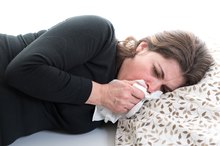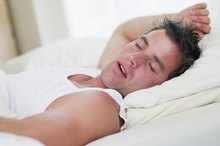Breathing Exercises for Sleep Apnea
Sleep apnea is a condition where you cease breathing several times at night while you sleep 4. Two chief causes exist: your throat tissue obstructs the airway or your brain fails to signal your muscles to breathe. Either occurrence results in unrefreshing sleep, snoring, high blood pressure, heart problems and more. Performing breathing exercises is one treatment technique your physician may recommend. These exercises can strengthen the throat muscles, reducing sleep apnea symptoms, according to “The New York Times. 124”
If you are experiencing serious medical symptoms, seek emergency treatment immediately.
Balloon Breathing
Breathing to inflate a balloon can strengthen the throat muscles, according to Helpguide.org, a non-profit educational wellness website 4. Take a balloon and place your lips around the opening. Breathe in through your nose, then blow into the balloon. Inflate the balloon as much as you can with your exhale, then breathe in release the air. Without taking the balloon away from your mouth, repeat the exercise five times. Stop if you begin to feel lightheaded.
- Breathing to inflate a balloon can strengthen the throat muscles, according to Helpguide.org, a non-profit educational wellness website 4.
- Take a balloon and place your lips around the opening.
Tongue Hold
Breathing Exercises for Stuttering
Learn More
This exercise simulates your breathing at night, training your body how best to breathe. Press the tongue to the roof of your mouth. Try to place more than the tongue’s tip -- use as much length as you can. Breathe in and out through the nose in a slow, controlled manner as you hold the tongue in place.
- This exercise simulates your breathing at night, training your body how best to breathe.
- Try to place more than the tongue’s tip -- use as much length as you can.
Morning Breathing
Perform this exercise immediately upon waking up each morning. Stand and bend forward at the waist, letting the arms dangle loosely. Bend the knees slightly to maintain your balance. Slowly inhale, rolling your back up slowly, one vertebrae at a time. Let your head be the last to straighten. Hold the breath for 3 to 5 seconds while standing, then exhale to lower the body back down to your starting position. Repeat two to three times.
- Perform this exercise immediately upon waking up each morning.
- Bend the knees slightly to maintain your balance.
Warning
4 Exercises to Strengthen the Esophagus Muscle and Improve Swallowing
Learn More
Breathing exercises are linked with treating mild cases of sleep apnea -- not ones that cause more severe symptoms, such as long periods of not breathing 14. If you experience sleep apnea or suspect you may have the condition, see your physician before solely self-treating your sleep apnea with exercises 4. Examples include your partner telling you that you snore loudly or appear to have breathing interruptions when you sleep. If you consistently feel tired throughout the day, even when you have slept a sufficient amount of time, this can be another symptom associated with sleep apnea and indicate the need for medical treatment 4.
Related Articles
References
- MedPageToday.com: Breathing Exercises May Relieve Sleep Apnea Symptoms
- "The New York Times": Throat Exercises Can Relieve Sleep Apnea
- Health.com: Exercising Throat Muscles May Relieve Sleep Apnea
- Helpguide.org: Sleep Apnea
- University of Maryland Medical Center: Relaxation Techniques
- Health.com: Breathing Exercises for Relaxation and Better Sleep
- Cowie MR. Sleep apnea: State of the art. Trends Cardiovasc Med. 2017;27(4):280-289. doi:10.1016/j.tcm.2016.12.005
- de Godoy LB, Palombini LO, Guilleminault C, Poyares D, Tufik S, Togeiro SM. Treatment of upper airway resistance syndrome in adults: Where do we stand? Sleep Sci. 2015;8(1):42–48. doi:10.1016/j.slsci.2015.03.001
- Cleveland Clinic. Sleep Apnea. Updated January 29, 2015.
- Dempsey JA, Veasey SC, Morgan BJ, O'Donnell CP. Pathophysiology of sleep apnea. Physiol Rev. 2010;90(1):47–112. doi:10.1152/physrev.00043.2008
- Franklin KA, Lindberg E. Obstructive sleep apnea is a common disorder in the population-a review on the epidemiology of sleep apnea. J Thorac Dis. 2015;7(8):1311–1322. doi:10.3978/j.issn.2072-1439.2015.06.11
- Cleveland Clinic. Sleep Apnea: Diagnosis and Tests. Updated January 29, 2015.
- Cleveland Clinic. Sleep Apnea: Management and Treatment. Updated January 19, 2015.
- Rosenberg R, Bogan R. Armodafinil in the treatment of excessive sleepiness. Nat Sci Sleep. 2010;2:95–105. doi:10.2147/nss.s6728
- Puhan MA, Suarez A, Lo cascio C, Zahn A, Heitz M, Braendli O. Didgeridoo playing as alternative treatment for obstructive sleep apnoea syndrome: randomised controlled trial. BMJ. 2006;332(7536):266-70. doi:10.1136/bmj.38705.470590.55
- American Sleep Apnea Association. What is Sleep Apnea?
- American Academy of Sleep Medicine. "International classification of sleep disorders: Diagnostic and coding manual." 2nd ed. 2005.
- Collop, N. "The effect of obstructive sleep apnea on chronic medical disorders." Cleveland Clinic Journal of Medicine. 2007 74:1.
- Durmer, J et al. "Pediatric Sleep Medicine." American Academy of Neurology Continuum. 2007; 153-200.
- Epstein, LJ et al. "Clinical guideline for the evaluation, management, and long-term care of obstructive sleep apnea in adults." J Clin Sleep Med. 2009; 5:263.
Writer Bio
Rachel Nall began writing in 2003. She is a former managing editor for custom health publications, including physician journals. She has written for The Associated Press and "Jezebel," "Charleston," "Chatter" and "Reach" magazines. Nall is currently pursuing her Bachelor of Science in Nursing at the University of Tennessee.









